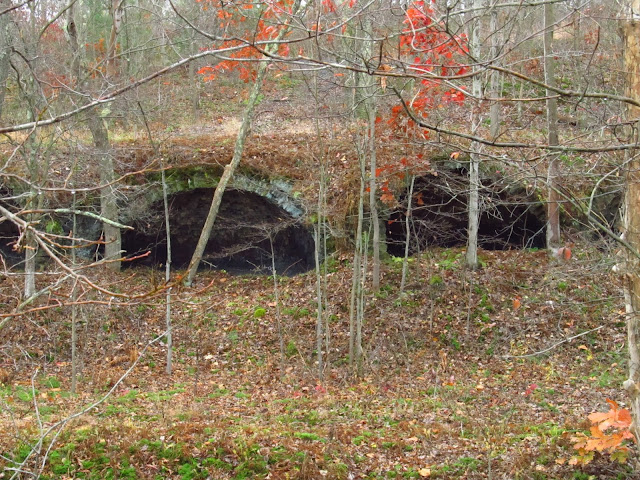The Leckrone No. 1 mine and coke works date back to 1899 and were operated by the Eureka Fuel Company. The Eureka Fuel Company was the fuel end of the Federal Steel Company of Chicago and was the second largest company merged in the steel combination. Eureka also owned plants at Footedale and Buffington. After January 31, 1902, the H.C. Frick Coke Company took over operations and eventually acquired it for good on March 28, 1903. By 1928 the coke plant had two batteries of block and one battery of bank ovens totaling 516 ovens. It is uncertain when the mine and coke works shut down.
The company store remains and dates back prior to the Frick era. Across from the company store is the ruins of the office building. The back wall remains as well as the foundation. What is interesting about this building is a cast iron door frame on the rear wall. It almost looks like an old vault door. Apparently this building served as the post office as well as the Superintendents office. Next to the company store sits the ice house which dates back to 1901.
There is another building further down the road that may have been a boiler house or a machine shop.
Update 3/23/14: The Leckrone mine map does list the ruins of the building across from the company store as "office".
 |
| The company store. |
 |
| This is the ice house next to the store. I'm sure it was modified to a garage later but it's a nice old building. |
 |
| This is the post office/superintendents office across the street. |
 |
| Exposed basement. |
 |
| This is the top of the iron door frame. |
 |
| The door frame itself. Maybe a vault? |
 |
| Plaster remaining on the wall. |
 |
| The front door of the company store. Yes, there is a light on. |
 |
| Apparently the company store sold gas at one time. |
 |
| Side view of the company store. |
 |
| A view of the coke ovens from the store. |
 |
| The ovens are deteriorated but the ground is really clear. |
 |
| These ovens are on the opposite side of the dock area. |
 |
| A little bit of remaining block from the dock wall. |
 |
| It started raining. |
 |
| This is the flooded dock area where the trains would come in to load up the coke. |
 |
| This is the other building down the road that may have been a boiler house or machine shop. |
 |
| Some of the patch houses behind it. |
 |
| This is inside that building. |
 |
| It's nice to see an intact window that hasn't been smashed out. |
 |
| Front door. |
 |
| This was sitting by a side door. |
 |
| Rear of the building. |
 |
| These sit behind the houses. Either ice houses or spring houses. |















Thank you for these photos, and your wisdom. My great grandfather Paul Draula lived and worked here from 1912 unril his death. All five of his children were born in Leckrone, including my grandfather Steve, who also worked here in the 1930s and after WWII.
ReplyDeleteWow! Thanks so much for looking and commenting.
DeleteThe building you refer to as a machine shop / boiler house is in fact the treatment plant where they treated Rail Road ties. I lived a few doors up from a guy that worked there.
ReplyDeleteNice! Thanks!
DeleteI grew up in Leckrone and my cousin used to run the train for the treatment plant and used to play on the huge stacks of lumber. Many good menories of company store and post office across road
ReplyDeleteThanks for this! My grandfather worked at the company store as a teen before graduating and enlisting for WWII - and his father was a miner there. If anyone has stories with the Berti family I'd love to hear them.
ReplyDeleteDoes anyone know of the Nagy and Walczy families that lived in Leckrone. Both my grandfather's worked in the coal mines there. In fact both my parents were born on the same street in Leckrone....lots of fond memories visiting my grandparents there when growing up as a kid!
ReplyDeleteDoes anyone know of the Nagy and Walczy families that lived in Leckrone. Both my grandfather's worked in the coal mines there. In fact both my parents were born on the same street in Leckrone....lots of fond memories visiting my grandparents there when growing up as a kid!
ReplyDeleteThe building down the road was used to treat Railroad ties, I believe with creosote. There used to be a very large tank past the building that had tracks leading to it. It would be filled with ties and pressurized with creosote. Environmental regulations and newer tie manufacturing methods put an end to this facility. Ties used to be stacked at this location probably for US Steel.
ReplyDeleteMy great grandad was killed in this mine. The Frick fortune was built on the blood of miners.
ReplyDeletemy nan lives right by these and would love to look at them
ReplyDeleteWe have recently acquired and are working to restore the Porter 0-4-0 steam locomotive that hauled timber to the creosote treating facility pictured above. If anyone finds photos of the railroad or locomotive from back then, please feel free to reach out to Fox Island Railroad Company. Thank you!
ReplyDeleteI grew up in the house next door to here in the 90s and early 2000s due to my grandmother owning the home at the time. She worked at the post office and would send me up to here with the mail that needed put in the drop box. I miss being here so much!!! This was so awesome to see and read. Thank you!
ReplyDelete